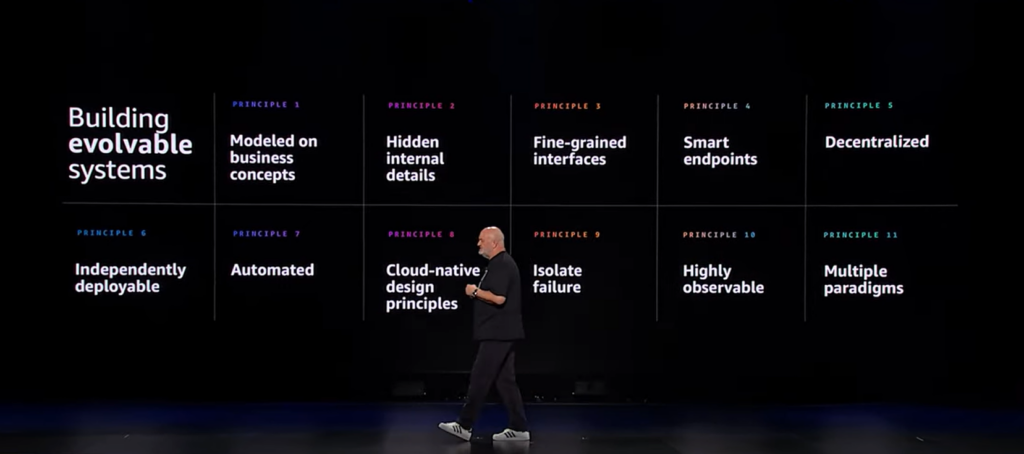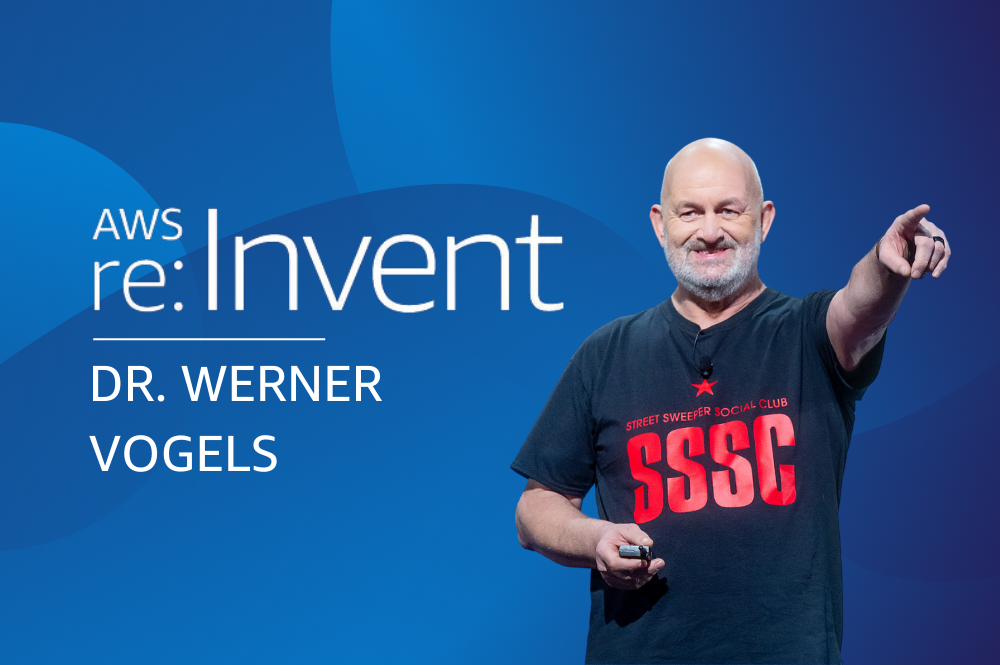“Complexity grows from simple origins.” This thought-provoking quote from Dr. Werner Vogels’ keynote at AWS re:Invent 2024 perfectly encapsulates his vision for scalable and resilient systems. As Amazon’s VP and CTO, Dr. Vogels has had a front-row seat to the incredible evolution of technology and AWS. His message? To keep up, we need to embrace constant learning and adaptation. During his address, he didn’t just discuss theory. He laid out actionable strategies for designing systems that prioritize simplicity without compromising scalability or resilience. A picture was painted on how to navigate today’s intricate digital world while keeping an eye on the future.
In this blog, we’ll unpack six of Dr. Vogels’ key strategies for embracing complexity. These practical steps will help you confidently navigate the challenges of modern technology—let’s dive in!
The Art of Managing Complexity in Fast-Growing Companies
“Complexity can neither be created nor destroyed, only moved somewhere else.” Tesler’s Law teaches us. In his keynote, Dr. Werner Vogels brought this powerful quote to life with an insightful analogy about bicycles.

Figure 1: Tesler’s Law – The Inevitable Nature of Complexity and Its Constant Evolution
Many assume complexity is just about the number of components, but that’s not the full story. Think of a unicycle—deceptively simple, with very few parts. Yet, mastering it is an uphill battle, requiring incredible balance and precision. Contrast that with a tricycle, which is incredibly stable but lacks the agility to handle sharp turns. Then there’s the bicycle: a system with more components than either a unicycle or tricycle but striking the perfect balance. It’s harder to master than a tricycle but far simpler to ride than a unicycle which offers flexibility and efficiency in harmony.
The key takeaway? True simplicity emerges when complexity is managed thoughtfully, empowering growth, innovation, and adaptability.
Turning Complexity into Strategy
Dr. Werner Vogels has a knack for making the complex relatable. At the event, he captivated the audience with his insights on managing complexity in rapidly growing systems. He emphasized that complexity itself isn’t the enemy—it’s how you handle it that matters. Intentional complexity is purposeful, designed to help systems scale and meet demands. On the other hand, unintended complexity sneaks in unplanned, bogging down innovation and creating inefficiencies.
In his keynote, he highlighted Amazon S3 as a standout example of managing complexity with purpose. Originally designed with eventual consistency, S3 embraced a level of complexity to support its massive scale. However, when Amazon transitioned to strong consistency, they transformed what could have been a limitation into a powerful asset. This shift not only simplified operations but also elevated reliability and enriched the user experience, demonstrating how thoughtful adjustments can turn complexity into a strategic advantage.
Warning Signs of Complexity You Need to Watch Out For
Before we dive into the key lessons of managing complexity, let’s take a moment to discuss how to spot the early warning signs. As Dr. Werner Vogels stated, complexity doesn’t announce itself with a glaring warning—it slowly creeps in, bit by bit, until you suddenly find yourself overwhelmed. He repeatedly pointed out that the secret to staying ahead isn’t about eliminating complexity. It’s about recognizing when it’s creeping in and addressing it before it becomes overwhelming.

Figure 2: The 7 Important Warning Signs of Emerging Complexity to Watch For
So, how do you know when complexity is starting to take hold? Dr. Vogels shared some key early warning signs to help us address the issue before it spirals out of control.
- Declining Feature Velocity: Slow progress in releasing new features.
- Frequent Escalations: More issues requiring higher-level intervention.
- Time-consuming Debugging: Increased difficulty in identifying and fixing problems.
- Excessive Codebase Growth: The codebase becomes bloated and harder to maintain.
- Inconsistent Patterns: A lack of uniformity in design and structure across the system.
- Dependencies Everywhere: Unnecessary or excessive dependencies between components.
- Undifferentiated Work: Teams working on similar tasks without clear division of responsibilities.
Dr. Vogels advised us to be aware of these signs that can help you stay proactive in managing complexity before it impacts your system’s performance and growth. That’s certainly something worth pondering.
6 Key Lessons from Dr. Vogels in Managing Complexity
Managing complexity is no small feat, especially in fast-paced, high-growth environments. But Dr. Vogels shared some truly eye-opening lessons at AWS re:Invent 2024 that made it all feel surprisingly achievable. Here are some of the key lessons he shared, packed with insights to help organizations navigate the fine balance between simplicity and growth.

Figure 3: The 6 Key Lessons in Managing Complexity According to AWS
1. Make Evolvability a Requirement
“Systems in constant flux never stepped in the same river twice.” Dr. Werner Vogels’ first lesson emphasized the importance of designing systems with evolvability in mind—systems that could adapt to long-term changes, not just short-term fixes. While maintainability addresses immediate needs, evolvability focuses on structural changes that help systems scale.
Dr. Vogels shared 11 key principles for building evolvable systems: from business-aligned designs and decentralized components to smart endpoints and cloud-native principles. A great example is Amazon S3, which evolved from 6 microservices to over 300, maintaining simplicity for users through modularity. Innovations like Blackfoot and AWS Nitro also show how evolvability enables AWS to scale its infrastructure without disruption.

Figure 4: The 11 Principles for Creating Adaptable and Scalable Systems
Key Takeaway: Evolvability is crucial for managing complexity, ensuring systems can scale and innovate over time. By embedding principles like flexibility, modularity, and decentralization, companies can create systems that grow with them.
2. Break Complexity into Pieces
In his second lesson on managing complexity, Dr. Werner Vogel used the frog-in-warming-water analogy to show how systems can become overly complex if small issues are ignored. He emphasized breaking complexity into manageable pieces before it becomes unmanageable.
Using Amazon CloudWatch as an example, Dr. Vogel explained how the service evolved from a simple tool into a “mega service” as new features were added which made it harder to manage. To address this, CloudWatch was restructured into smaller, modular components with clear APIs, allowing it to scale and handle vast amounts of data.
During his keynote, Dr. Vogel also stressed the importance of decomposition. This means breaking systems into independent components that can evolve over time. He further noted that a key warning sign that a service has grown too complex is when it’s no longer fully understandable by its engineers. By proactively managing complexity through decomposition, organizations can maintain scalability and adaptability as systems grow.
Key Takeaway: Breaking systems into smaller, cohesive components with clear APIs is essential for managing complexity, supporting scalability, and ensuring long-term adaptability.
3. Align Organization to Architecture
The third lesson was presented by none other than Andy Warfield, the engineer behind Amazon S3. In his talk, he shared valuable insights on how S3 has successfully managed both organizational and technical complexity over the past 18 years. One compelling analogy he used was that of a tractor pull, where the weight becomes heavier with each pull. This parallels how progress becomes increasingly difficult as complexity builds.
Moreover, Warfield highlighted the need to recognize that organizations are as complex as the systems they build, requiring constant attention and adaptability. He shared two key principles that have guided S3’s success:
- Fostering a culture of “constructive fear”
- Promoting ownership at every level
Warfield also emphasized the importance of teams being “a little bit scared,” acknowledging that success can lead to complacency. This fear drove teams to continuously question their decisions and processes, especially during periods of rapid growth. For example, the implementation of a “durability threat model” encouraged teams to proactively address potential risks before making changes. This fostered a culture of learning and improvement.
Alongside this, Warfield focused on ownership, which he defines as a blend of agency and urgency. He argues that when teams are empowered to make decisions and feel responsible for delivering results, they take pride in their work and drive high-quality outcomes. S3’s approach to ownership involves presenting teams with problems rather than solutions and trusting them to find the best answers. It also includes offering a combination of pressure and support to drive success.
Key Takeaway: Build small, empowered teams that challenge the status quo. Encourage ownership by blending agency with urgency, fostering a culture of innovation, responsibility, and continuous improvement.
4. Organize into Cells
In his fourth lesson, Dr. Werner Vogel emphasized managing operational complexity by organizing systems into smaller, independent building blocks, known as cell-based architectures. This approach helps contain issues within specific cells, preventing them from affecting the entire system, which is crucial as systems scale.
He further explained that without this isolation, disturbances like customer load spikes or failures can disrupt the entire system. By assigning customers to specific cells using algorithms like hash functions, these disruptions are minimized. Tools such as simple routers and shuffle sharding further ensure smooth operation and system availability. While balancing the size of cells is key, ensuring they’re large enough for significant workloads but small enough for effective testing is crucial as well.
Key Takeaway: Organizing complex systems into cells helps isolate issues and prevent disruptions, ensuring the system remains reliable, secure, and efficient. This approach minimizes impact and helps maintain long-term operational stability.
5. Design Predictable Systems
During lesson five, Dr. Werner Vogel stressed the importance of designing systems that eliminate uncertainty to enhance manageability and reliability. He highlights how uncertainty introduces complexity, making systems harder to operate and scale effectively. For example, AWS faced challenges when designing a configuration system for its load-balancing service, Hyperplane. While an event-driven architecture seemed like a viable solution, it led to unpredictable workloads and bottlenecks.
To address this, AWS opted for a simpler, more predictable approach: storing configuration changes as files in Amazon S3 and having load balancers operate on a fixed schedule, processing these files periodically. This approach avoids spikes, backlogs, and unpredictability, leveraging S3’s availability and resilience.
He also shared how Amazon Route 53’s health checkers use periodic updates to maintain a comprehensive configuration file, avoiding the chaos of event-driven updates and ensuring smooth DNS resolution.
As Dr. Vogel aptly put it, “Simplicity requires discipline.” By embracing this principle, systems can avoid unnecessary complexity, ensuring they remain reliable, scalable, and efficient.
Key Takeaway: Design predictable systems to reduce the impact of uncertainty. By intentionally simplifying operations, you can create systems that are reliable, manageable, and scalable while avoiding unnecessary complexity.
The same principle applies to securing your cloud storage. If you’re looking to better protect your data in the cloud, take a look at our blog, Top 5 Amazon S3 Security Strategies to Shield Your Data. We’ve got practical tips to help you keep your data safe and your cloud environment secure.
6. Automate Complexity
In his final lesson on managing complexity, Dr. Werner Vogels highlighted the importance of automating processes to efficiently manage large-scale systems. He encouraged us to shift the focus from asking “What do we automate?” to “What don’t we automate?”
At AWS, automation is a default approach for tasks such as ensuring durability, scaling capacity, and even building new regions, with minimal human involvement. Network reconfiguration processes are fully automated, and manual intervention is limited to situations requiring significant judgment. In the rare instance a human is involved, AWS uses a practice where one person executes commands, and another oversees them to minimize errors.
Dr. Vogels also discussed security as a key area where automation is essential. AWS integrates security from the design phase and uses automated systems powered by neural networks to process trillions of DNS requests and identify malicious domains in real-time.
Another example is in support ticket management, where “agentic workflows” use specialized agents to autonomously handle tasks like categorizing and prioritizing tickets, reducing the cognitive burden on humans. These agents streamline processes, escalating issues only when needed.
By embracing automation, AWS reduces complexity, improves efficiency, and allows human resources to focus on tasks requiring higher expertise.
Key Takeaway: Automate everything that doesn’t require high judgment. By doing so, organizations can reduce complexity, increase efficiency, and free up human resources for tasks where their expertise is truly needed.
Harness the Potential of Simplexity with AWS and Cloudelligent
As we wrap up this year’s AWS re:Invent, it’s clear that Dr. Werner Vogels’ vision for managing complexity in technology is both enlightening and actionable. The concept of “simplexity” involves embracing complexity in ways that enhance efficiency, scalability, and resilience. This approach offers a refreshing way to build systems that can thrive in the constantly changing digital landscape. By following his insights, we can turn seemingly overwhelming challenges into opportunities for growth and innovation.
Like Dr. Vogels, Cloudelligent understands that complexity, when approached thoughtfully, can drive innovation. We focus on building systems that are both adaptable and scalable, empowering businesses to not only manage complexity but leverage it for success. As we look ahead to 2025, we’re here to help you navigate the challenges and unlock new opportunities in the rapidly evolving business environment.
Are you ready to harness the power of simplexity and drive your business forward? Connect with Cloudelligent today to explore how we can help you simplify your processes and position your organization for long-term success.










